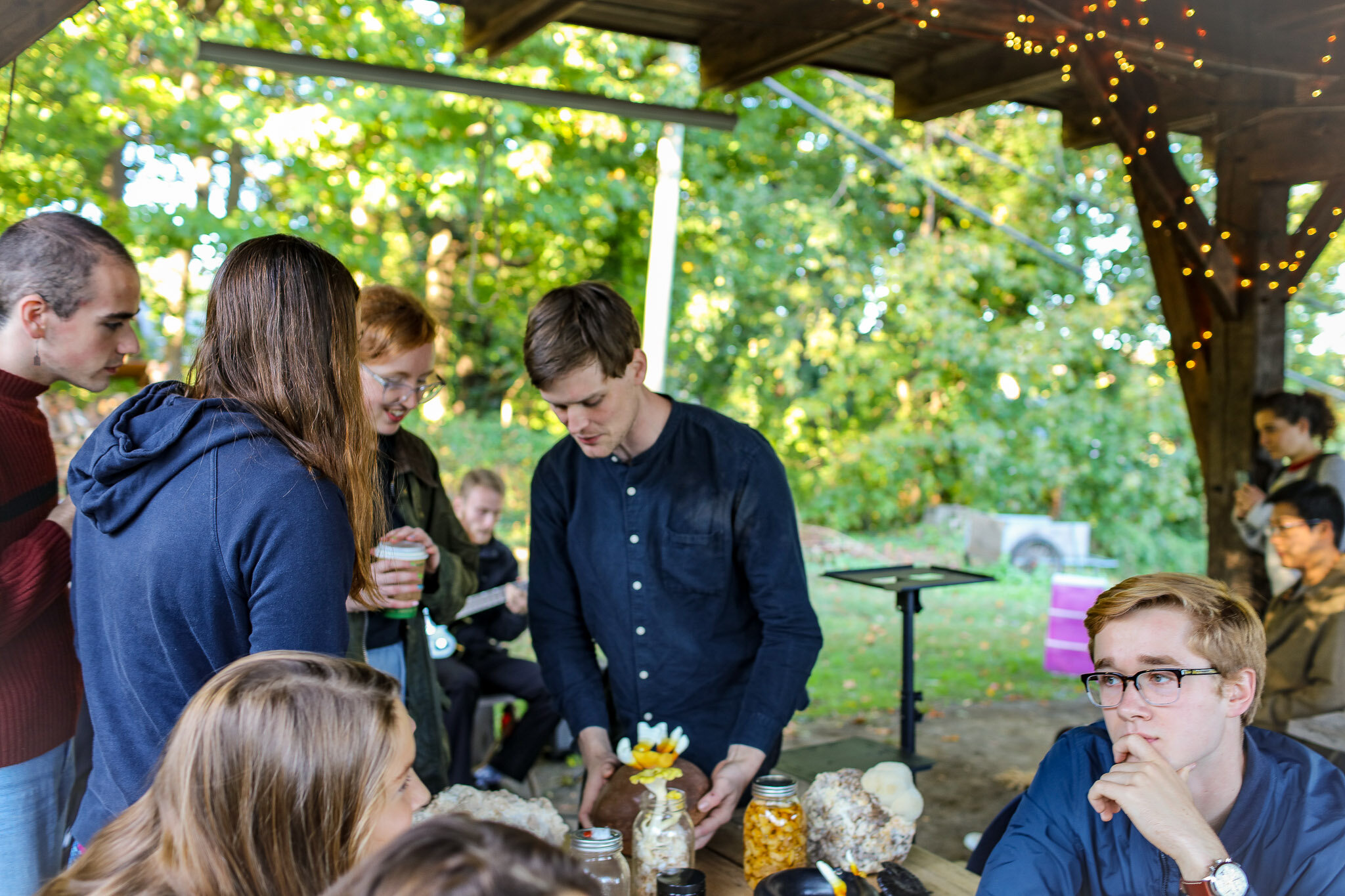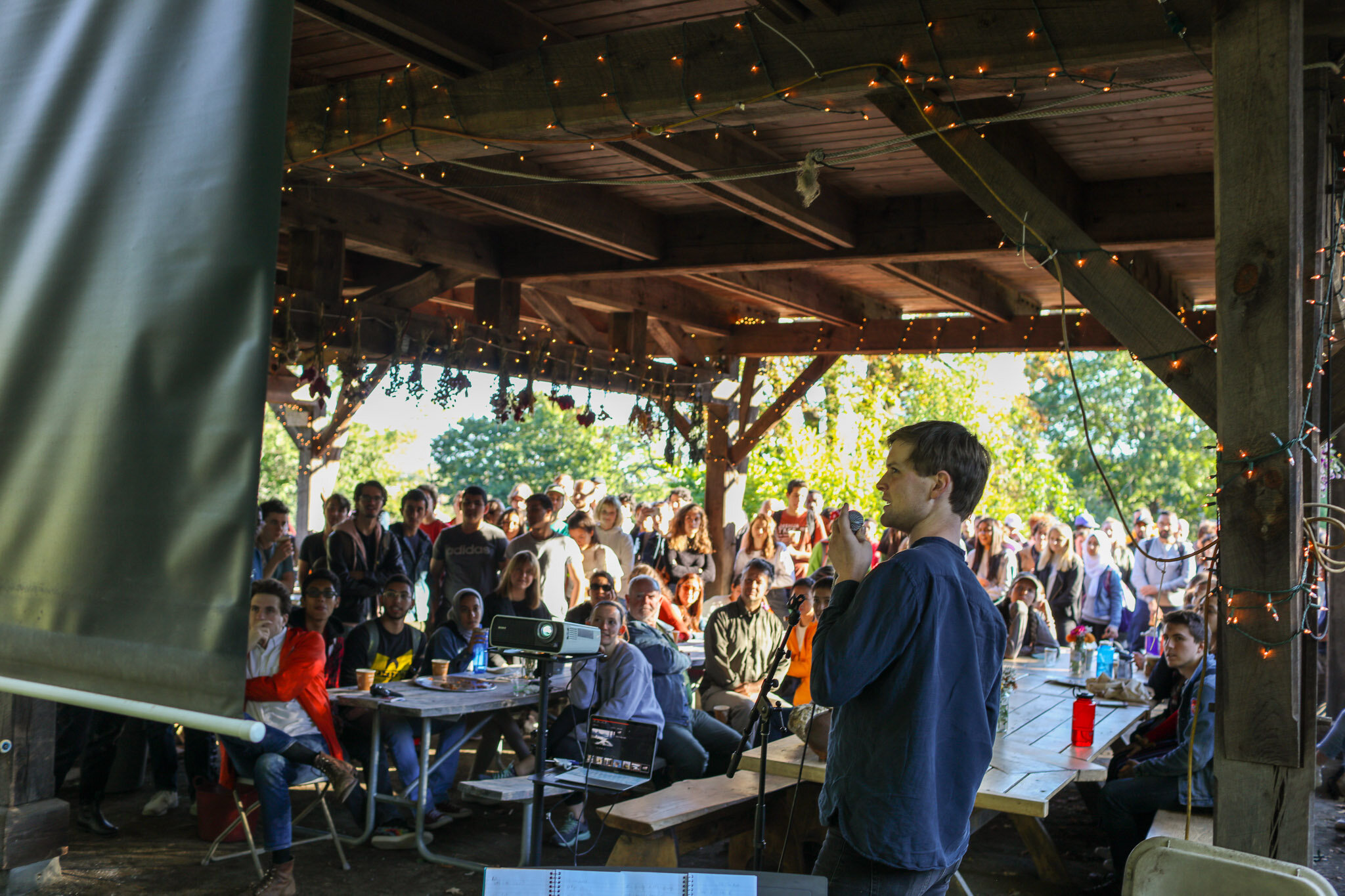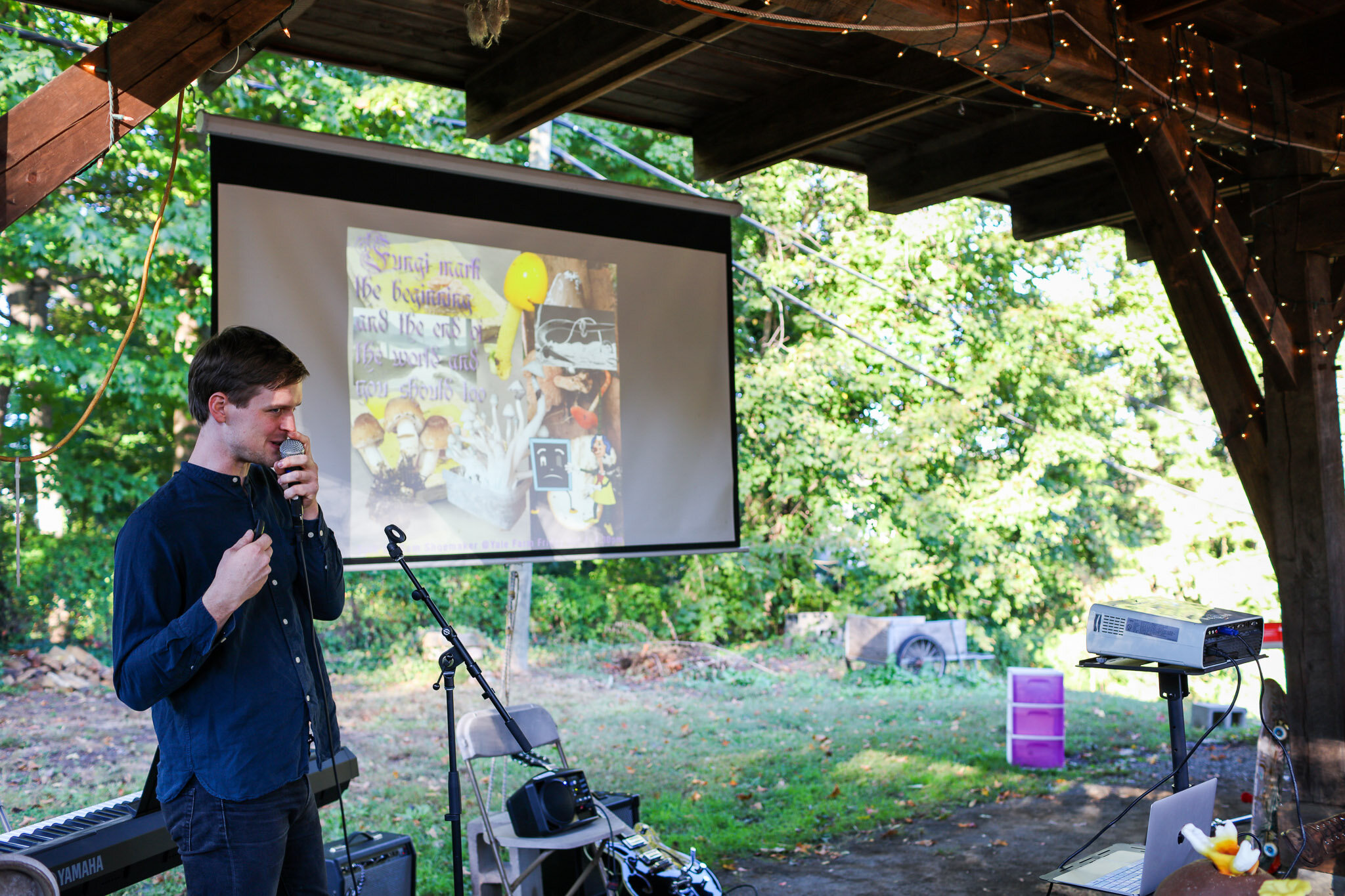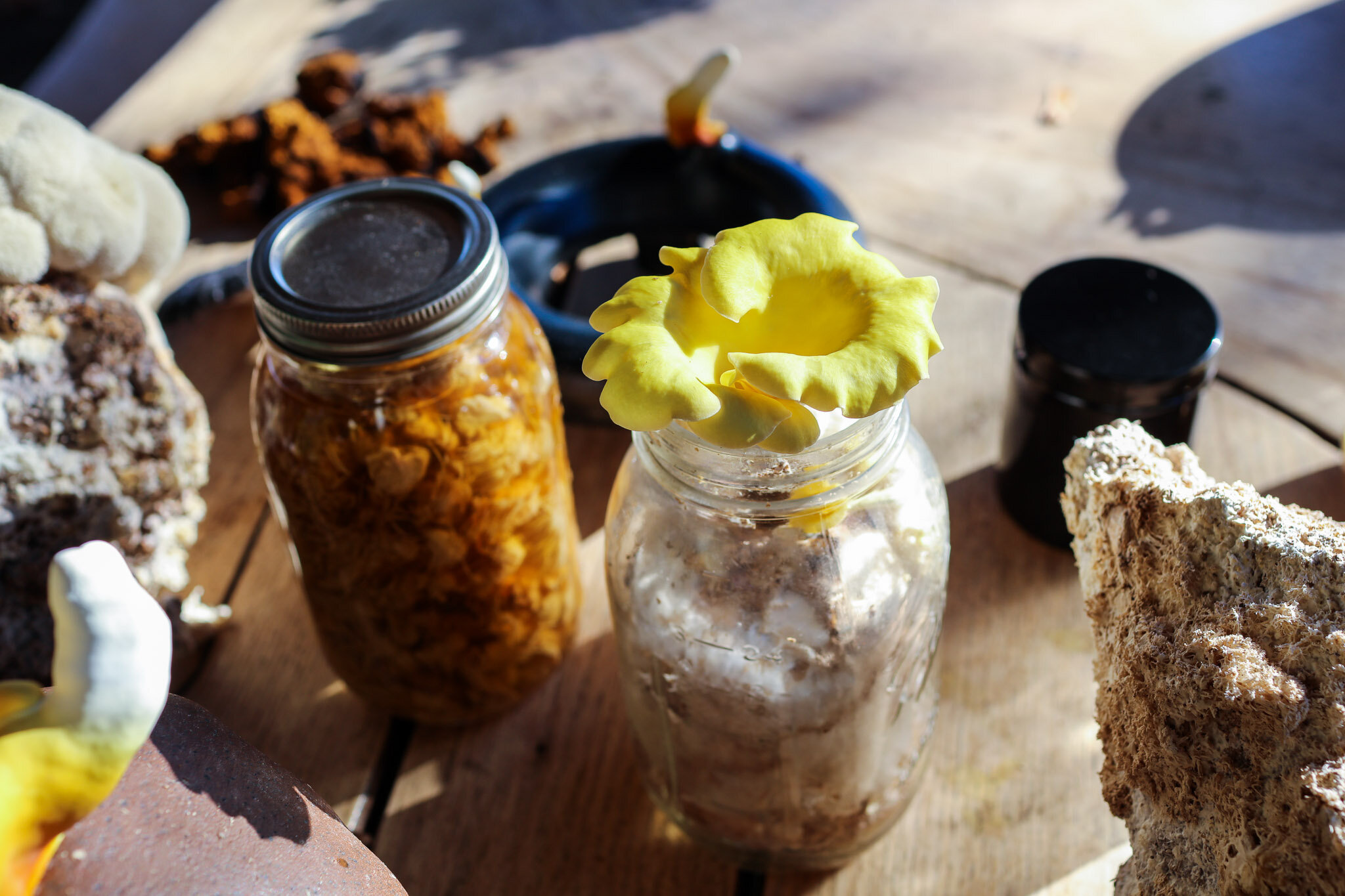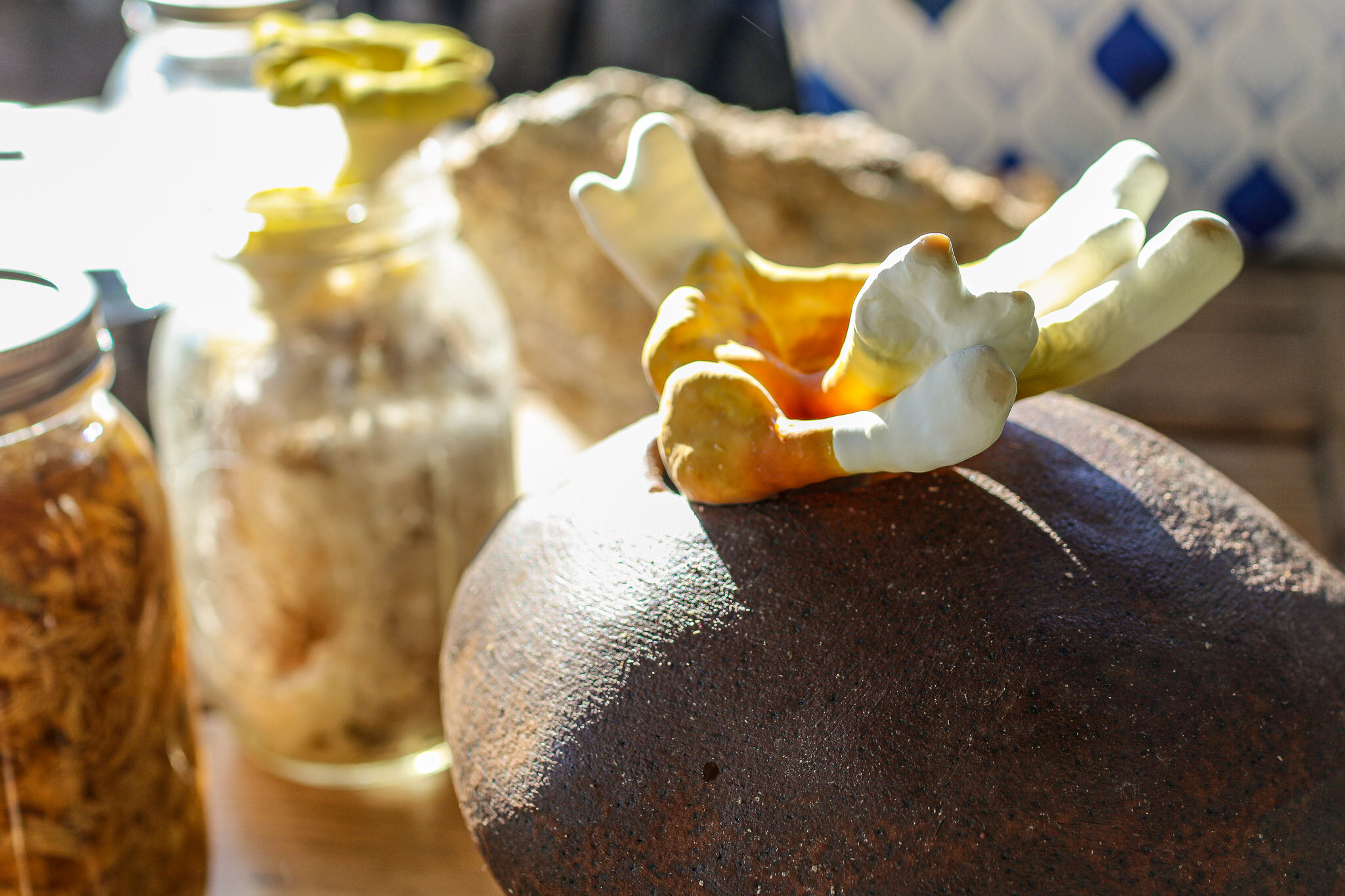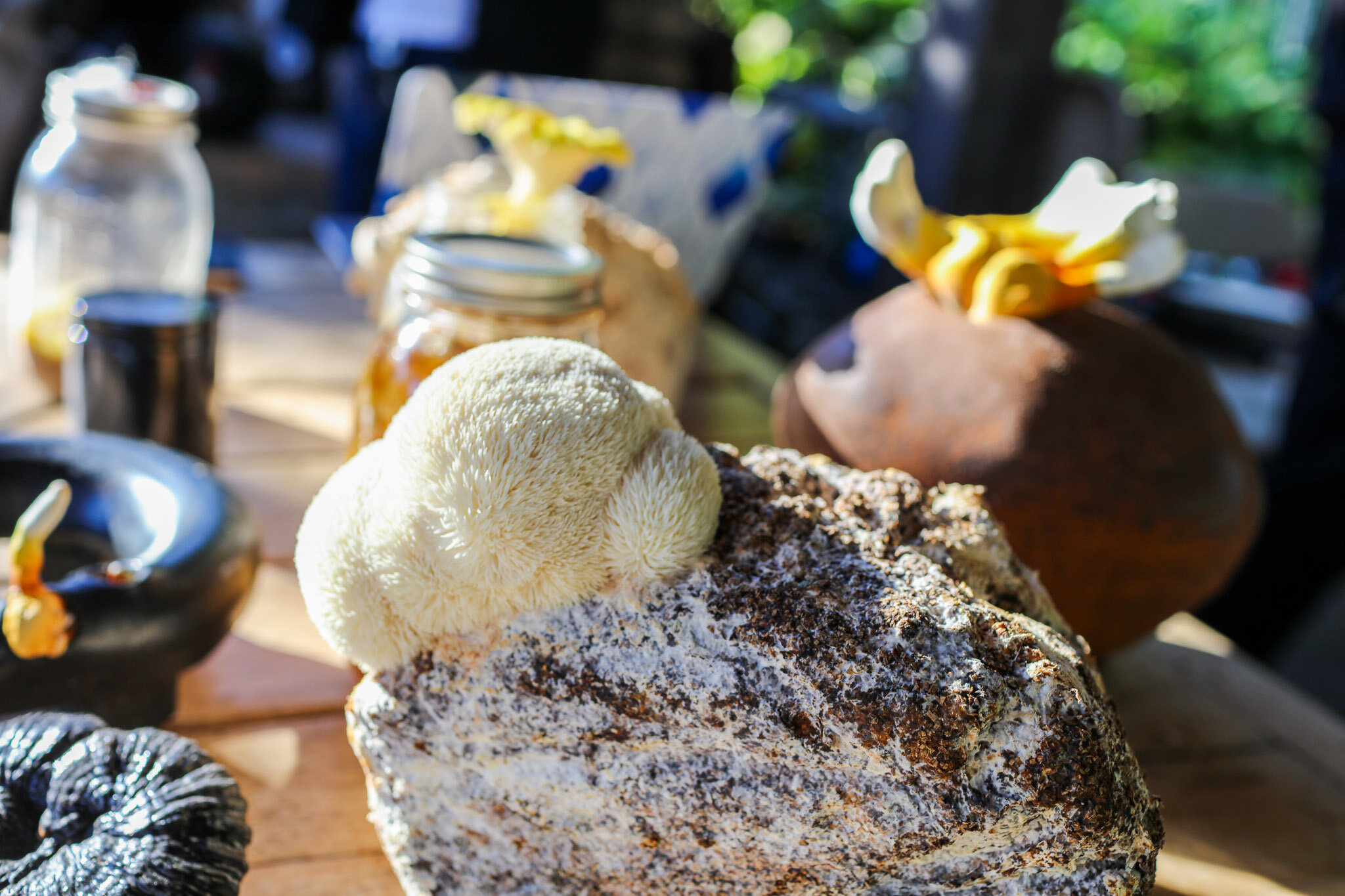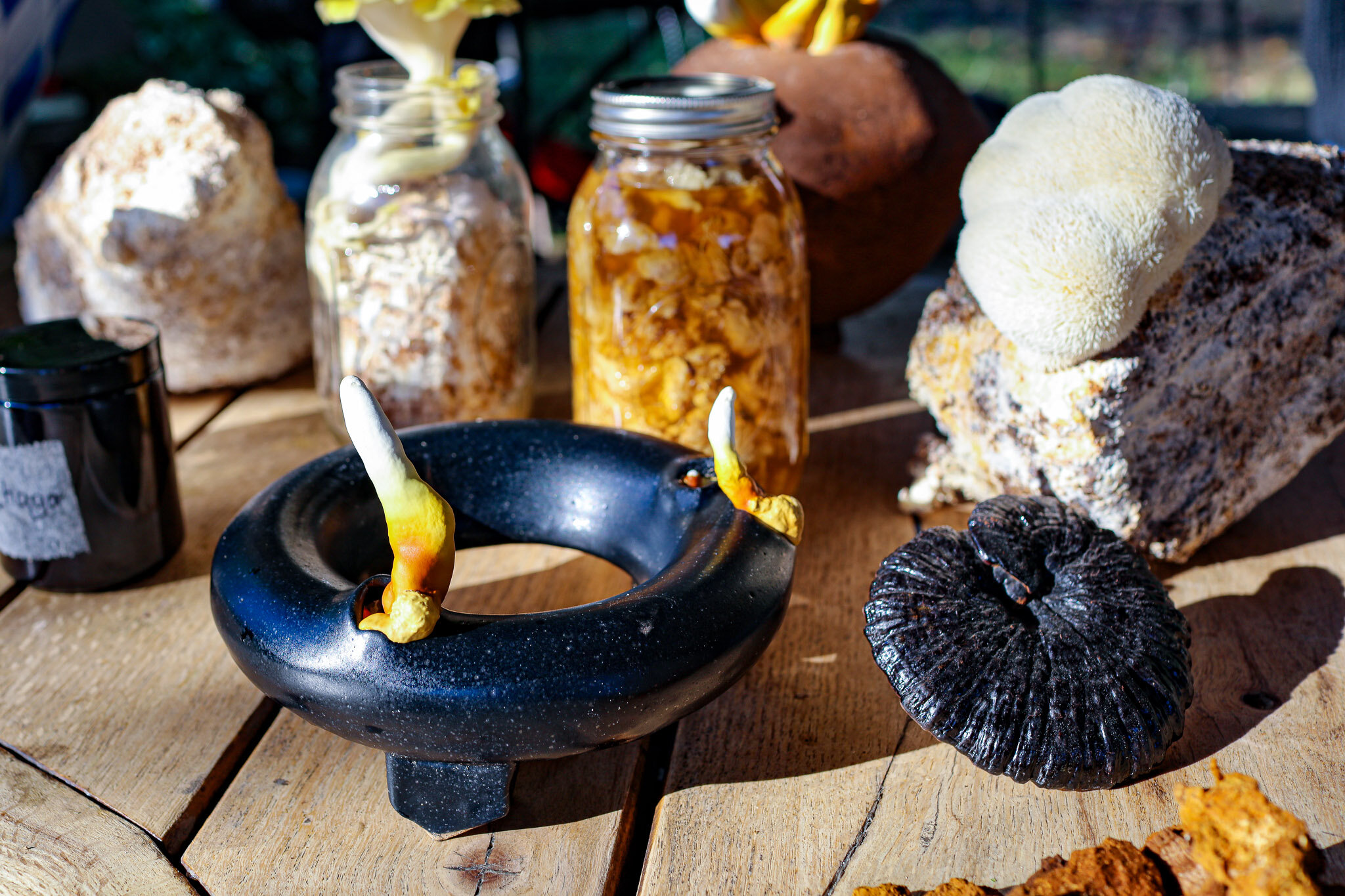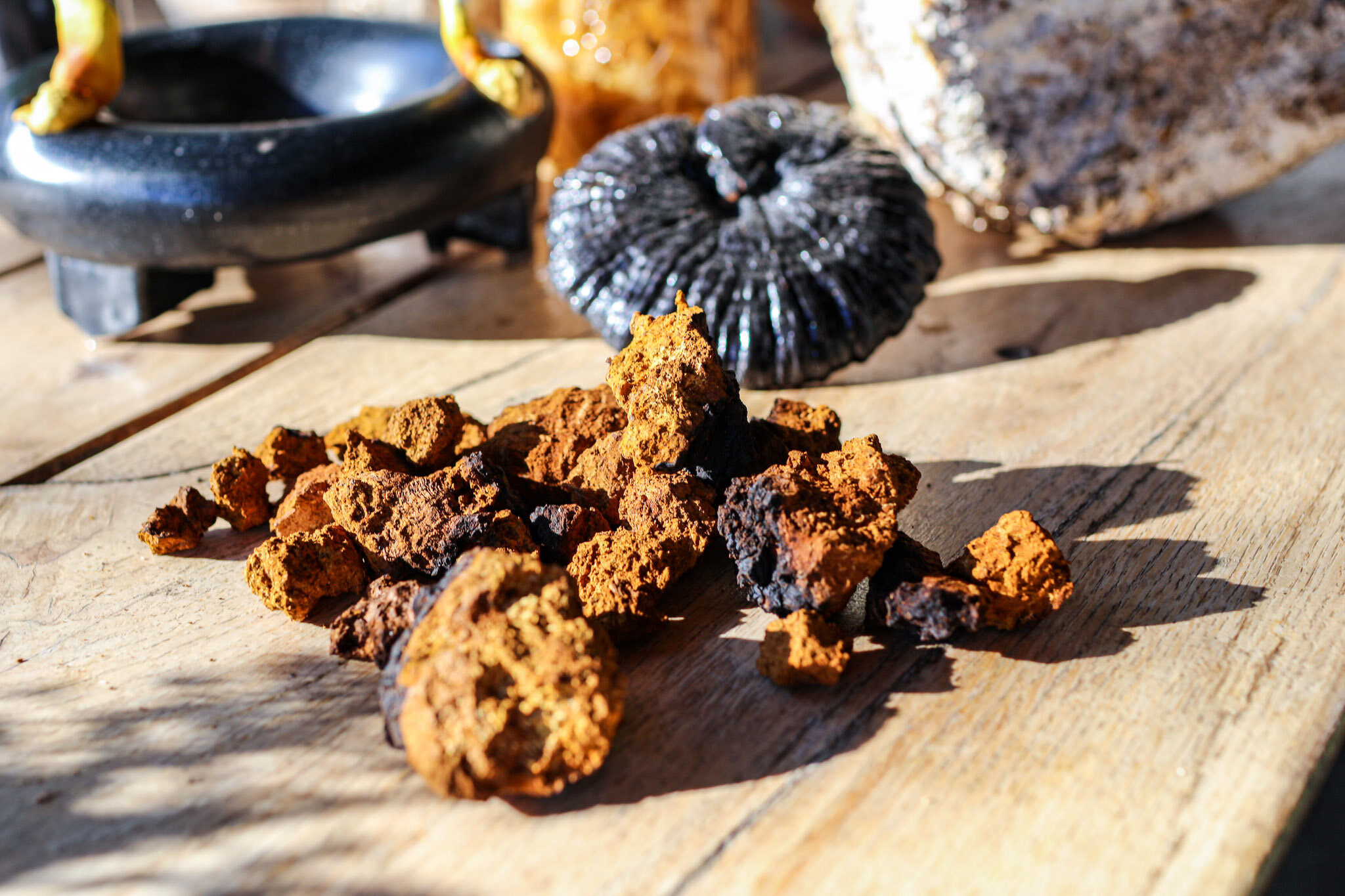With some of our in-person programming on pause this year to prevent the spread of COVID-19, we’re revisiting past moments to reflect and learn. In this Q+A, Noa Hines ’21 chats with Sam Shoemaker ART ’20, to go beyond his knead 2 know presentation last fall, “The Mysteries of Fungi”.
Noa Hines ’21 is part of the YSFP’s communications team. She is an Architecture major concentrating in Design. Her favorite part of the job is using photography to to help document all of the joyful memories at the YSFP.
Noa Hines: What inspired you to create art with fungi?
Sam Shoemaker: I had been interested in mushrooms for many years before I started working with fungi in my artwork. I actually was trying to keep them separate from the studio, because I was afraid that if all of my hobbies were about art making, then I would make very poor company and I would turn all of the things that I enjoy into work. But the obsession grew and I eventually realized that I needed to bring the mushrooms into the studio because I was spending so much time researching and thinking about them. So that led me to start cultivating fungi and not just identifying them.
It was actually one of my fears to become “another fungi artist,” but now I think about it very differently because it actually makes a lot of sense that artists are drawn to fungi. They're very enigmatic and unpredictable organisms. They sort of fall between the cracks in terms of how we think things work. They’re connective tissue that brings all of the familiar together but lay mostly out of sight and underground. And the community that has studied them both in the US and internationally has been sort of on the fringes. Most people who study fungi are citizen scientists and self-taught autodidacts. I think artists usually fit into that category: they're self-taught, they’re craftsmen, they’re researchers. So a lot of the people that I seek counsel from are not people with PhDs in biology. And most of the people who are doing the most cutting-edge science do not come from a traditional science background. I felt very invited for that reason to get into it.
That [knead 2 know] was the first talk that I gave on fungi at Yale and that was a great opportunity. I didn't really know how to present or organize my thoughts so I went up there, ranted for 15 minutes before sitting down, and then everyone started eating pizza. [Someone] said “What? You didn't open it up for questions.” So clearly I have a lot to learn about public speaking, but that experience led to other talks and I'm starting to refine it. Since then, I’ve taken my skills back with me to California and I'm starting an urban mycology farm. I've just finished building my lab in a basement.
“...one of the things I want to convey with these talks is that this [field] is really ripe for the picking, that anybody can jump in. You don’t have to have a PhD.
”
NH: I have a lot of questions about that, but first, do you want to talk about any of the other talks you’ve given and what it's been like to participate in that?
SS: I have mostly been giving talks on Zoom. I gave a talk to a class at CalArts; some friends were organizing a Zoom lecture series when we all went into quarantine. I started sharing what I know and making myself as available as possible to people who want to learn because the people that I learned from made themselves very available, for free, to share what they know. I've really tried to respect that tradition of contributing back, because I've been given a lot.
Another thing about giving these talks that has been really healing and exciting is that we are in an unprecedented time politically, ecologically. There's tragedy on a global scale. And yet, fungi are this really unexplored part of our world where we can find so many answers and there are so many places where we have not applied science and research. There's so much excitement right now in the field of mycology that we should pay attention to because we need to look to new solutions. We have to do things very differently in the way we think about food and the way that we think about conserving our soils and our old growth forests. And one of the things that I want to convey with these talks is that this [field] is really ripe for the picking, that anybody can jump in. You don't have to have a PhD.
For example, I’ll ask a group of mycologists who have been doing this for 30 years, “Instead of growing things in plastic bags, why don't we grow them in ceramic pots?” Just really simple things like that and they’ll say, “We just have never tried it.” Even compared to the art world, [mycology] is such a small community. And nothing is set in stone, all the techniques that we use have all been developed in the past hundred years.
“Mushrooms have always been the organisms to take care of the waste and things that we don’t know how to break down and process ourselves...”
NH: One thing I remember from your talk was that you brought up this one species of fungi, and really stood out to me how resilient it was. You presented these conditions that seem toxic to other organisms or humans; fungi can just thrive in that. That's definitely something to think about in terms of how we preserve food, and how we may change the way we're thinking about cultivation, especially when there's such a shortage of resources.
SS: It keeps me up at night, so it's very easy to convey the excitement that I have. I've wanted to start a book called 10 Conversations with 10 American Mycologists. The mycologists that I know would all have very different answers if I were to say, “Right now I have $10 million that you can invest into research or any myco-related project. Where would you put it?” Some people would say food, some people would say remediation, some people would say medicine and the research of psychedelics.
There's just so many places that we need to get into and a lot of airtime is spent right now on psychedelics. When people hear the words, “mushrooms,” or “shrooms,” or “mycology,” they assume drugs. And I think there are a lot of really exciting things happening in that world; Berkeley just opened a department on their campus for the study and advancement of psychedelics, I forget which terms they use, but they're studying psilocybin and LSD and other things for therapeutic medicinal purposes. And you don't have to go far before you hear an NPR piece or some podcasts talking about microdosing.
But the things that I don't think we hear as much about are sustainable food systems that we can find through mushrooms and mycology. Most people don't hear about remediation and I think those topics need a lot more airtime because we have an ocean full of plastic. We have put heavy metals in our soil all over the planet and we have spilled oil into our water sources.
Mushrooms have always been the organisms to take care of the waste and things that we don't know how to break down and process ourselves; asphalt, stone, concrete, landfills, plastics— mushrooms have tremendous potential to do this and to store our carbon banks on this planet. And the more we use fungicidal pesticides and treatments that deplete our rhizomatic systems and our ecosystems, the more damage that we do.
“I want to do everything fast and loose because I have an artist brain. In art school, they just tell you, ‘you can do anything you want, there are no rules.’ With mushrooms, there are rules.
”
NH: It sounds like there are a lot of ways this field can address the global state of the environment. What are some things that have been a bit challenging in your work, and what are you looking forward to?
SS: I’ve been very fortunate. I am finding my obsession and practice at a time when there's a lot of interest and support for people doing what I'm doing. I'm starting this mushroom farm in LA that doesn't have an official name yet, but I am more or less the only person who's attempting to do this in Southern California right now, which is still a big surprise to me. There's challenges with growing mushrooms, but I feel that I've been ushered to the front of the line because a lot of people want to do this and they don't know how to get access to fresh, locally grown mushrooms.
I would say the biggest challenge is learning to scale that up. Mushrooms are still very mysterious to me and I'm still getting experience on how to grow them at a much larger scale than what I'm used to. My small studio projects are very different from trying to produce 100 pounds of fresh mushrooms for farmers’ markets every week. Another thing is if I let my space get dirty; I have this lab, and I have to mop the floor every day and scrub the surfaces with bleach, alcohol, and peroxide. I've become very knowledgeable about my cleaning routines, and I haven't been known to be somebody that mops every day. I’m kind of paranoid because I'm creating these ideal environments for fungi and molds to grow, but I need the mushrooms to grow. Not mold. In order to do that I can't go in there being sweaty and covered in bacteria and BO. I need to be in there squeaky clean with bleached clothes on, and then do my work very, very carefully.
I want to do everything fast and loose because I have an artist brain. In art school, they just tell you, ‘you can do anything you want, there are no rules.’ With mushrooms, there are rules.
NH: Can you walk me through the process of growing mushrooms?
SS: Mushrooms don't grow from seeds. The caps of most mushrooms will drop spores. I have worked with other laboratories that produce commercially viable, high-performing strains of mushrooms, which get brought on a petri dish of agar. A wedge of that will get moved to more agar so I can keep replicating this strong mushroom culture. Then I'll take some of the wedges and add them to sterilized grain. Rye grains are very good for mushrooms, but those are very difficult to find in bulk organic, so I'm using wheat berries (Note: Sam is moving towards getting an organic certification).
So I get these dry berries, I soak them, I cook them, and then I sterilize them at just the right moisture content. Then I introduce a piece of that agar wedge to the grain; when it spreads across the grain, that's called colonization. When it's fully colonized and the mycelium is spread all the way across, I break those pieces up and then I'll bring them to more grains. That is what is going to produce spawn, which you can kind of think of as seeds. When I put the spawn on the sawdust that I grow the mushrooms on, it’s inoculating the substrate, a bit like how you would plant a seed in the soil.
I've sourced all of my sawdust from an Amish farm, because it processes the oak without any motor oils or additives that could be less ideal for food-grade materials. Then I supplement that sawdust with organic soy holes, which is the byproduct of soy and soybeans. Those holes that get tossed to the side are great nutrition, my mushrooms can chew right through that. So that gets bagged up and heated for a 36-hour cycle where they're all in steam at around 200 degrees Fahrenheit, so they get pasteurized really well. It comes out, I add the spawn, they grow, and then I move them into the fruiting chamber. So while they're colonizing, it's a dry, kind of warm room they’re incubating in. Then when the mushrooms are ready to grow, I take those blocks, I move them into my wet fruiting room where it's 90% humidity. Eventually, I slash the bags open and the mushrooms come out!
I cool those mushrooms off, collect them, and then those are going down to the farmers’ markets or maybe personal chefs. I have other friends who are kind of working with mushrooms and we’ll trade our agar plates like it’s a club. “I can't get this one to grow, you try this! Oh, this one likes it a little bit colder, or, this one doesn't like to have too much oxygen, so I'm going to put a little tarp there.” You spend time with the mushrooms to see what they like. If they're happy, you're happy.
And then after I harvest the mushrooms off of those blocks, they are really great for compost. I have a friend that owns a cactus store and he is starting to add myceliated blocks to his cactus soil. He says that with the experiments that they're doing they're getting 30 years of growth out of their cactuses in just three years.
NH: Do you have any final thoughts you want to share?
SS: I think a really big change is about to happen where [mushrooms are] going to become a big business. And I think that will bring us two steps forward, one step back in a lot of ways.
I really want to see mushrooms fully utilized in this world, but it's already becoming this huge corporate environment, where it used to be a very counterculture science. As I start this business the biggest question that I have is, how can I make mushrooms in a way that serves everyone and not just the kind of Prius/Whole Foods crowd? I think that hasn't really been answered to yet; the potential is there. We know we can produce this protein-rich food at a fraction of the resources that we use to produce meat and a lot of other crops that we grow in the wrong places. This is a great solution for feeding our urbanized world, but we just need to find a way to make it accessible and beneficial to more than people who just want to spend money on a fancy ingredient.
As things become big business, keeping that citizen science alive is really important. But that free education moment is not going to be here forever. And I can't just donate everything that I grow. I have to be able to make some money to keep the lights on in the studio and just keep this place running. As somebody right out of school, I'm very naively idealistic about everything, but I think things can be better than we've done them before. The more you get your head into what people are doing, the more you realize that there's a lot more happening. A lot of doors in the world are closing, a lot of doors in the world are opening, and mushrooms are a really exciting place [that] we should turn our mind’s eye to.


